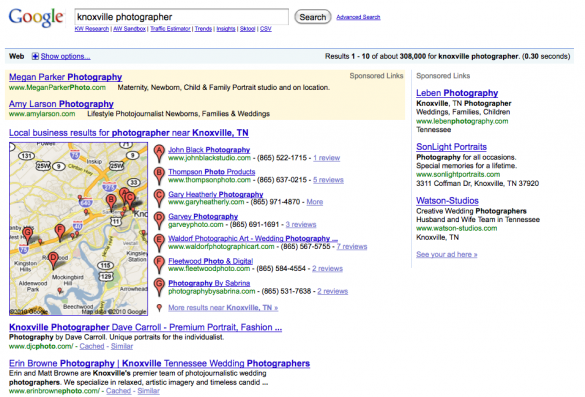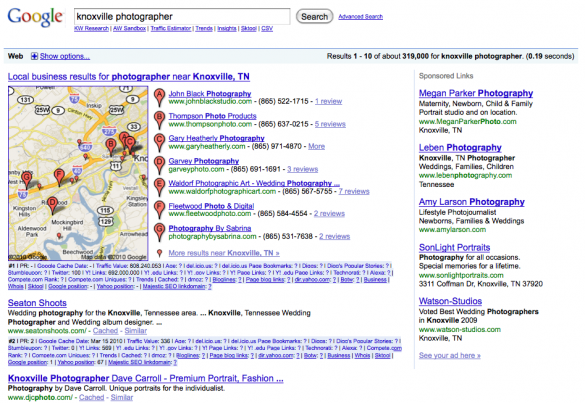Auto-Generated Online Ads Use Some Web Images
 Last Friday, the New York Times ran an article titled, “An Ad Engine to Put ‘Mad Men’ Out of Business” which talked about an online service called PlaceLocal that automatically creates online ads. From the article:
Last Friday, the New York Times ran an article titled, “An Ad Engine to Put ‘Mad Men’ Out of Business” which talked about an online service called PlaceLocal that automatically creates online ads. From the article:
“New software called PlaceLocal builds display ads automatically, scouring the Internet for references to a neighborhood restaurant, a grocery store or another local business. Then it combines the photographs it finds with reviews, customer comments and other text into a customized online ad for the business.
The program, developed by PaperG, an advertising technology company in New Haven, Conn., is aimed in part at small businesses just beginning to advertise on the Web sites of local newspapers or television stations, said Victor Wong, its chief executive.”
I was immediately intrigued about how the service works so I went to the site and created an ad for a my favorite deli here in Detroit, The Russell Street Deli. The ad it created in less than two minutes was fairly basic, but included moving images (using Flash) gathered online, and testimonials presumably from reviews on the internet:
OK, so it’s not the sexiest ad in the world, but for someone with a limited budget that precludes hiring a photographer, it would certainly work online. The user can select from a number of sizes including vertical and horizontal banners and the site creates the new ad instantly. Being a photographer, I was interested in how they were selecting images and whether any respect being paid to copyrighted content. My query to them in a form on their website:
I am curious as to how you eliminate findviagra copyrighted images from ads that are created on the fly, or if you do. If not, how are the creators being compensated for the licensing of their images? Cheers, Blake Discher, www.groozi.com
Less than an hour later, Victor Wong himself responded. His answer:
Hi Blake:
Thank you for your interest in our product. We are definitely respectful of right holders, and make best efforts to make sure the elements used to create advertisements follow comply with copyright regulations. Specifically, we have taken the following steps to address copyright concerns:
. We use content from our partners who have secured content rights
. We use content from the websites of advertisers so they can reuse their existing content in their advertisements
. We offer a library of stock photography as an alternative to customers without their own photos
. We strictly adhere to restrictions of photographs offered under the Creative Commons or other relevant licenses
. We require users to certify that all the elements used do not infringe intellectual property of others
I hope this is helpful.Thanks,
Victor
A few thoughts… It’s refreshing to hear that Mr. Wong is mindful of copyright issues and has created a system in which safeguards are in place to protect rights holders. Aggregation of internet content began with news gathering sites and it’s no surprise to see it move to this sort of use. Because this model is sure to expand, it’s even more imperative that before images are placed online, they be registered with the copyright office, watermarked, and contain full metadata including your contact information for licensing.
What do you think of this service?










 Most SEO experts agree on at least one thing: incoming links to your web pagees are very important when it comes to determining where your page will appear in the search engine listings. An impediment to getting these valuable links is that, by default, most blog platforms are set up so that a “Do Not Enter” sign is added wherever a link appears in a comment. This means that search engines will not “count” the link as they are crawling the internet. In geek-speak this is known as a “no-follow”, originally designed to help stop comment spam. With today’s ease of comment moderation by blog owners it’s really not needed. In fact, what it actually does is remove some of the incentive for your readers to contribute the blogging community by commenting on your posts.
Most SEO experts agree on at least one thing: incoming links to your web pagees are very important when it comes to determining where your page will appear in the search engine listings. An impediment to getting these valuable links is that, by default, most blog platforms are set up so that a “Do Not Enter” sign is added wherever a link appears in a comment. This means that search engines will not “count” the link as they are crawling the internet. In geek-speak this is known as a “no-follow”, originally designed to help stop comment spam. With today’s ease of comment moderation by blog owners it’s really not needed. In fact, what it actually does is remove some of the incentive for your readers to contribute the blogging community by commenting on your posts. I’m really looking forward to getting out to Las Vegas this coming week for the 2010 Convention and Trade Show at the MGM Convention Center March 4-11. It’s always a huge gathering of photographers from around the world, with a great lineup of speakers, this year including me!
I’m really looking forward to getting out to Las Vegas this coming week for the 2010 Convention and Trade Show at the MGM Convention Center March 4-11. It’s always a huge gathering of photographers from around the world, with a great lineup of speakers, this year including me!  groozi.com is a blog about negotiating and web marketing. Weekly posts are written primarily by me, Blake J. Discher, a
groozi.com is a blog about negotiating and web marketing. Weekly posts are written primarily by me, Blake J. Discher, a 
